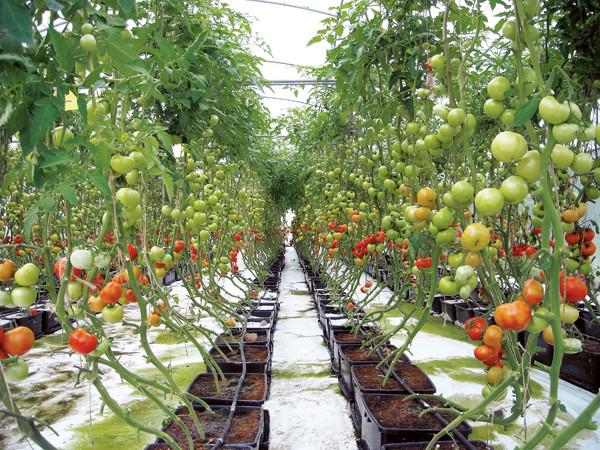
Unfortunately, many nutrient solution formulations and use criteria frequently lead to essential plant elemental insufficiencies, sometimes clearly evident as visual plant and/or leaf symptoms, or not so easily observed with plants growing poorly but without visual symptoms.
I was asked by a grower at a recent greenhouse tomato conference if I was available to make a visit to his greenhouse as he was having difficulties with his tomato crop, as both plant growth and fruit quality have been below expectations. Thinking that the difficulty was associated with the operating characteristics of the greenhouse, he said that he had made changes based on a consultant’s recommendations. However, the status of the tomato plants did not change. Seeking my advice, he was ready to turn to his growing system, thinking that it may be the reason for poor plant performance. I asked him to send me a sample of the rooting medium for analysis. From the analytical results based on three different assay procedures, excessive levels of several elements as well as an imbalance among several elements that are both competitive and synergistic, were found. The rooting medium was coir, with the nutrient solution used being organically-based, necessary to meet the requirements for marketing the harvested fruit as “organically-grown.” Coir is a terrific product, but you do need to buffer it before using it as a medium. Read this article for information on how to buffer coir for use as a hydroponic medium.
When growing hydroponically in a rooting medium, there are three factors that will affect plant growth, the elemental composition of the nutrient solution, its frequency of application, and the volume applied with each irrigation. In the formulation of a nutrient solution, there are two critical factors, the actual concentration of each element in the formulation, and the ratio balance among the elements.
Initially, using either a fresh inorganic or organic rooting medium, the plants will be supplied their required essential elements from what exists in the applied nutrient solution. However, with each irrigation, a portion of the applied nutrient solution remains behind in the rooting medium, the amount retained depending on the physio-chemical properties of the rooting medium, such as its water-holding capacity (also related to its ease of drainage), internal water-holding space, and for the major cations, its cation exchange capacity. From this point on with each subsequent nutrient solution irrigation, the plants will now have two sources for their essential nutrient elements – that left behind from earlier irrigations and that existent in the nutrient solution being applied with the next irrigation. A commonly recommended procedure is to monitor the electrical conductivity (EC) of the retained nutrient solution in the rooting medium, and when it reaches a certain level, the rooting medium is leached with water. Such leaching is costly in terms of the volume of water required, and the requirement to collect the leaching water as it can be considered an environmentally hazardous waste. In addition, the leaching may not remove all the accumulated soluble elements.
With this accumulation of elements in the rooting medium (even with periodic leaching), another reaction begins to occur, the formation of precipitates, mainly calcium phosphate and calcium sulfate that will also trap or surface attract other elements, such as zinc, manganese, copper, iron and magnesium. Now plants in the rooting medium will have three sources of elements as the acidic nature of plant root surfaces will dissolve portions of the formed precipitates, releasing dissolved elements that can be easily root absorbed. At this point, the nutritional status of the plant is out of control and nutrient element insufficiencies begin to occur, with plant growth and fruit yield being adversely affected.
For the grower attempting to grow “organically,” suitable sources of organic fertilizers that are balanced in their elemental makeup are difficult to find. Therefore, an organic fertilizer may be selected to supply a particular element, or suite of elements, but may also contain an element, or elements, at the same or greater concentration but not needed by the plant at that rate. In addition, most organic fertilizers do not have a consistent elemental content from batch to batch, therefore their use assuming the same expected elemental composition.
Most nutrient solution formulations are of higher nutrient element content than needed, exposing the plant roots to excessive elemental concentrations. I have found that diluted nutrient solutions (one-half to one-third of full-strength formulations) will provide sufficient element concentrations when properly applied based on meeting the water needs of the plant (no more, no less). There are also several other ways of controlling the nutrient element exposure. For example, either irrigate only with water between each nutrient solution irrigation or irrigate with a nutrient solution at the beginning of each day (full formulations being needed) and then with only water the rest of the day to meet the water needs of the plant. However, these methods of nutrient solution use require experience and skill on the part of the grower to ensure that nutrient element sufficiency is maintained. Unfortunately, most who market their nutrient solution products do not provide the required instructions on how to use their product in order to avoid nutrient element accumulation from occurring in the rooting medium, while at the same time, meeting the nutrient element needs of the plant to ensure sufficiency.
For this coir rooting medium grower, he will have to begin again with fresh coir and then devise a nutrient solution formulation and application procedure that will satisfy the nutrient element requirement of the tomato plants while preventing the accumulation of elements within the rooting medium that will adversely affect the plant’s nutritional status.
J. Benton Jones, Jr. has a PhD in Agronomy and is the author of several books. Dr. Jones has written extensively on hydroponic growing and outdoor vegetable gardening employing sub-irrigation hydroponic growing systems.
Related Articles & Free Email Newsletter
How to Grow Juicy and Tasty Tomatoes




Comment here